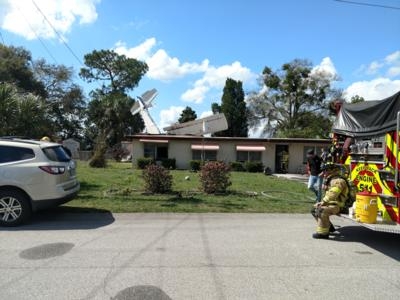Airplane Impacted A House Shortly After Takeoff, Instructor Pilot Fatally Injured
The NTSB has released its preliminary report from an accident which occurred February 23 in Winter Haven, FL. The commercially-rated instructor pilot was fatally injured when the airplane, a STOL Aircraft Corp UC-1 amphibious airplane, impacted a house shortly after takeoff from Winter Haven Regional Airport (KGIF), Winter Haven, FL. A commercially-rated pilot who was receiving instruction in the airplane sustained minor injuries.

According to the report, the commercial pilot receiving instruction (the pilot) told the NTSB he and a colleague were receiving initial airplane multiengine sea training from the flight instructor in the accident airplane. The accident flight was the third flight of the day.
According to the pilot, the instructor advised him before takeoff that he would introduce a simulated engine failure at some point during takeoff or climbout. Shortly after takeoff from runway 23, about 200-300 ft above ground level (AGL), the instructor reduced the throttle on the left engine and the left engine stopped producing power, and the propeller feathered. They identified the failed engine, the instructor took over the flight controls, and selected a forced landing site.
During the descent, the flight crew's engine restart procedures were unsuccessful and they determined that the airplane would not reach the selected forced landing site. The instructor then chose a lake to the airplane's left as an alternate site. During the left descending turn, the airplane slowed, the left wing dropped, and the airplane impacted a house, seriously injuring one of its occupants.
A witness in a fuel truck at KGIF stated she watched the airplane fly overhead. She saw both propellers rotating and watched as the left propeller stopped rotating. The witness said she then watched as the airplane "sank" in a descending left turn until it disappeared from view.
The pilot held a commercial pilot certificate with ratings for airplane single engine land, airplane single-engine sea, and instrument airplane He held a flight instructor certificate with a rating for airplane single-engine. His most recent FAA second-class medical certificate was issued October 24, 2017. He reported 820 total hours of flight experience on that date.
The flight instructor held an airline transport pilot certificate with ratings for airplane single- and multiengine land, and single- and multiengine sea. He held a flight instructor certificate with ratings for airplane single- and multiengine. His most recent FAA first-class medical certificate was issued January 25, 2019. He reported 15,000 total hours of flight experience on that date.
The five-seat, twin-engine, high-wing, amphibious airplane was manufactured in 1986. It was powered by two Lycoming IO-360, 180-horsepower engines, equipped with Hartzell two-blade, constant-speed propellers. A review of the airplane maintenance records revealed that a 100-hr inspection was completed on February 23, 2019.
Examination of the accident site revealed that the airplane came to rest inside the house and rested in a near vertical, nose-down attitude. All major components were accounted for at the scene. The cockpit area was destroyed and crushed inward. The top of the fuselage between the engines was crushed inward. The fuselage beyond the fifth seat was intact and undamaged. The throttle quadrant, which ran along the top of the cockpit, was separated during the impact sequence. The wings remained attached and were removed for recovery. After recovery of the airplane, control continuity was traced from the cockpit, through several cable breaks to all flight control surfaces.
The right-wing leading edge inboard of the engine was crushed inward. The front and inboard side of the cowling was crushed. The right-engine propeller blades displayed chordwise scratching and tip curling. The wing outboard of the engine was undamaged. The left-wing leading edge inbound of the engine was crushed. The left propeller blades were feathered and undamaged. There was damage to the outboard portion of the wing, which included wrinkled skin, and upward folding of the wing and skin. The wingtip was crushed inward.
The left and right engine crankshafts were rotated by hand at the propeller hub, and continuity was confirmed through the powertrain to the valve train and accessory section. Compression was confirmed on all cylinders of both engines using the thumb method. All of the ignition harness leads were intact and undamaged. The right engine's magnetos were manually rotated and produced spark at all terminal leads.
A test run of the left engine mounted on the left wing was attempted. An external battery and engine controls were connected, and an external fuel tank was plumbed directly to the fuel pump inlet. The engine started immediately, accelerated smoothly, and ran continuously at all selected power settings without interruption.
No evidence of preimpact mechanical malfunction was noted during the examination of the recovered airframe and engines.
(Source: NTSB. Image from file)
 ANN's Daily Aero-Term (05.17.24): Very High Frequency
ANN's Daily Aero-Term (05.17.24): Very High Frequency ANN's Daily Aero-Linx (05.17.24)
ANN's Daily Aero-Linx (05.17.24) ANN FAQ: Submit a News Story!
ANN FAQ: Submit a News Story! Classic Aero-TV: ANN Visits Wings Over The Rockies Exploration Of Flight
Classic Aero-TV: ANN Visits Wings Over The Rockies Exploration Of Flight Airborne Affordable Flyers 05.16.24: PRA Runway, Wag-Aero Sold, Young Eagles
Airborne Affordable Flyers 05.16.24: PRA Runway, Wag-Aero Sold, Young Eagles



